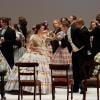
Uzbek pianist Behzod Abduraimov is no stranger to Los Angeles. In 2014, five years after winning the London International Piano Competition at age 18 with what The Daily Telegraph called “the most enthralling roller-coaster ride of a Prokofiev Third Concerto imaginable,” he made the first of several flashy appearances at the Hollywood Bowl with the Los Angeles Philharmonic. After his 2018 performance there of Sergei Rachmaninoff’s Second Piano Concerto, one enthusiastic critic suggested that “someone needs to book him at Disney Hall for a recital.”
That recital finally took place on Wednesday, Nov. 13. It was surely worth the wait. In a well-balanced and varied program of César Franck, Florence Price, and two of his Russian soulmates, Modest Mussorgsky and Sergei Prokofiev, Abduraimov treated a small but very devoted audience to a dazzling display of sensitive musicality, refinement, and impeccable technical mastery. (He had presented the same program at Cal Performances in Berkeley several days before.)

The powerful and physical style of playing for which he has been celebrated was shown to especially dramatic effect in the booming climaxes of Mussorgsky’s Pictures at an Exhibition and in Prokofiev’s 10 Pieces From Romeo and Juliet, both of which Abduraimov has recently recorded. His gifts for storytelling and finding subtle variations of color lent both these cycles a marvelous narrative flow that kept us on the edge of our seats. He expressed exquisite detail without losing momentum.
Abduraimov revealed a more tender and restrained aspect of his personality in Franck’s Prelude, Fugue, and Variation, originally written for organ. The Prelude opens with a lyrical tune in the style of J.S. Bach that Abduraimov rendered with delicate legato, subtle dynamic contrasts, and crystalline precision. As was the case throughout the recital, both treble and bass lines were distinct and skillfully differentiated. This was a sweet and genteel amuse-bouche to refresh the palate for the rougher and more substantial fare to come.
Abduraimov has said he feels a special affinity for the music of Mussorgsky because it reminds him of the Russian literature, cartoons, and fairy tales he absorbed while growing up in Tashkent. (Like most Uzbeks, he is bilingual in Uzbek and Russian.) Composed in 1874 for piano solo, Pictures at an Exhibition eventually became much better known in Maurice Ravel’s 1922 orchestral arrangement (performed by the LA Phil just one day after Abduraimov’s recital). Intended as an homage to the composer’s friend, artist Viktor Hartmann, the piece represents a stroll through a gallery show of Hartmann’s work. A repeated Promenade — a rolling episode in shifting 5/4 and 6/4 meter — takes us among the 11 paintings.
Abduraimov began briskly and forcefully with the opening Promenade but altered the color and tempo each time it repeated, providing a sense of continuity to what can seem a disjointed work. Similarly, he created entire cinematic visions out of each episode, from the haunting orientalism of “The Old Castle” to the approach and departure of a heavy Polish oxcart in “Bydlo.” The concluding “Great Gate of Kiev” pulsated with grandeur, pomp, and yes, huge sound. Abduraimov used his thumb to create the effect of pounding bells, resonant but not harsh.
Price’s 1929 Fantasie nègre No. 1 also has its roots in folk music, in this case the spiritual “Sinner, Please Don’t Let This Harvest Pass.” Abduraimov attacked the dense and challenging virtuosic variations on the theme with impressive bravura force, testing the limits of the Steinway but perhaps sacrificing swinging soul to technical display.
That Abduraimov has been closely associated with the music of Prokofiev is not surprising — he has the necessary savagery, tenderness, technical skill, and playfulness. In the 10 Pieces From Romeo and Juliet, published before the ballet’s premiere in 1938, he lingered over the sour dissonances and quirky rhythms, especially in “Montagues and Capulets” and “Mercutio,” but he also brought a warm, passionate tone to “Young Juliet” and “Romeo and Juliet Before Parting.” This energetic, focused, and very clean performance was perhaps the best account of this cycle I have heard, and it brought the audience to its feet.
Abduraimov generously responded to the prolonged ovation with two delightful encores: a gently nostalgic account of Rachmaninoff’s Prelude No. 5, Op. 32, and a blazing, athletic, ring-down-the-rafters rendition of Franz Liszt’s “La campanella,” the third of the Grandes études de Paganini, S.141.




